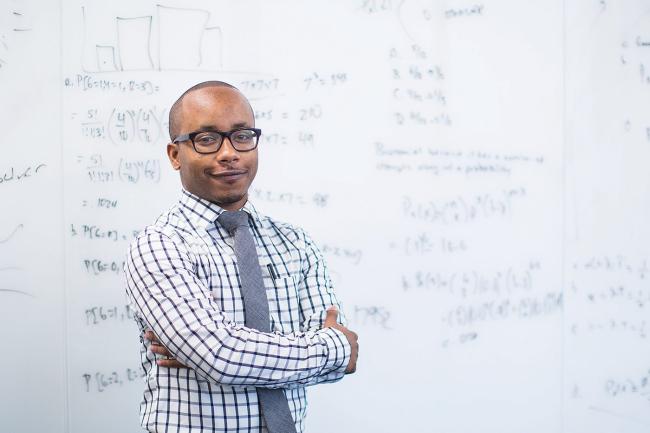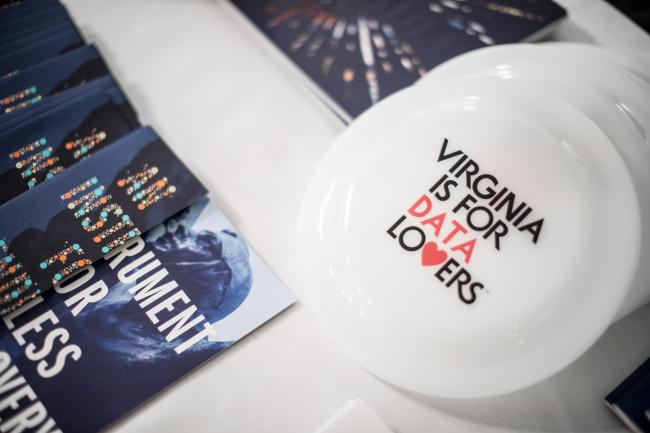Reggie Leonard
Reggie Leonard joined the Data Science Institute in 2015. He has served as a career counselor for data science students and alumni ever since and currently holds the role of associate director for career connections and ommunity engagement.

Job openings in data science continued to grow, but the professional landscape wasn’t always as well defined. When Reggie Leonard joined the Data Science Institute in 2015, it was more like the “wild West,” he said.
Job listings were at times confusing, and, in many cases, companies that weren’t actually doing data science were seeking data science applicants.
“It was really hard to help students figure out what jobs to apply to,” Leonard recalled.
Leonard knew something about professional uncertainty. He was a psychology major in college and remembers hearing from people who assumed he must be planning to go to graduate school since, they told him, there weren’t any jobs in his field.
“I realized how little reflection, and little space for reflection, I even had for making that decision for what was next,” Leonard said.
He would go on to graduate school, receiving a professional counseling degree at Liberty University, and found a new direction and purpose: career development.
After staying on at Liberty as a career counselor, Leonard learned about an opportunity that spoke to another interest of his: technology and innovation.
“Data science was on my radar, not necessarily as data science but more so as big data,” he said. He would join the Data Science Institute as assistant director of career services in June 2015, just after the first cohort of data science master’s students received their degree the month before.
Using LinkedIn, he reached out to as many new alumni as he could to make connections. “Have you landed something?” he said he would ask. “Let me see your résumé. Do you know how to interview for a data science opportunity?”
During that initial period, Leonard maintained his focus on building contacts with alumni and determined how he could best support them as they sought to launch their careers.
As time went on, Leonard’s career advice, like the degree program itself, would evolve to reflect the changing nature of the field.
“Two to three years into my time at Data Science, all business analysts and data analyst roles started to have R and Python” skill requirements, he said, referring to the programming languages. “The level of technical rigor for data scientists was increasing,” Leonard added.
In addition to Leonard’s work to build a career services component within the institute, an emphasis was also placed on ensuring master’s students were gaining the practical experience they would need through capstone projects.
In these projects, which continue to be required for graduation, students generally work with an academic, commercial, nonprofit, or governmental organization to develop a data science project designed to address a sponsor’s actual need. It’s a way for students to learn from, and hopefully overcome, the challenges that arise from tackling real, and often very difficult, data science questions.
“It’s a learning experience of how real data science works,” said Don Brown.
Arlyn Burgess recalled hearing from students who had been scheduled to present their capstone work to the institute’s advisory board during one of their initial meetings in 2015. The students were concerned they wouldn’t have anything compelling to show to board members because of the problems they had encountered.
“That sounds to me like your presentation,” Burgess said she told the group. It was an illustration of what Brown and Burgess referred to jokingly as the 80-20 rule: 80% of the time data scientists are cleaning and wrangling their data while the other 20% of the time they’re complaining about it.
Brown thought the experience was constructive for the board.
“I think the board members, when they met with students, that really helped them to understand that this was the way it was in the world and to expect that kind of thing,” he said.
Teaching students how to effectively present their research has long been an emphasis of Brown’s.
“We just constantly hammer talk about motivation,” Brown said.
“Why are you doing this? Why is this important to somebody?” he says he tells students as they are thinking about how to discuss their data science research with non-technical audiences, including during job interviews.
By the middle of 2016, the Data Science Institute had graduated its second class of master’s students, with the program rated 6th on a list of “Top 50 Best Value Big Data Graduate Programs,” according to Value Colleges.
Meanwhile, applications to the program soared to 438 by fall 2016.
Other research efforts were also gaining traction, with the institute participating in the development of many successful proposals, including those that received funding from the National Institutes of Health and the National Radio Astronomy Observatory.
Interest in data was also growing at the state level, with the institute holding conversations with Virginia officials, including hosting a state-wide Data Analytics Summit with the governor about how different state agencies were using their data.
The team even created swag that featured a twist on the well-known state tourism slogan for the event: “Virginia is for Data Lovers.” Given the high-profile nature of the visit, gaining approval just for their branding efforts proved to be a significant challenge for the institute in itself.
But their efforts paid off.
It was “great to see them want to be involved in this whole area, the era of big data and bringing data in to inform policymaking,” said Don Brown of those discussions with officials.
Priority was also placed on forging relationships with others in the Charlottesville community who had an interest in data science.
The institute collaborated with local analytics businesses to launch the Charlottesville Data Science Meetup, a group that held workshops and meetings focused on data science issues.
Working with the community has remained a hallmark of the School of Data Science. As Reggie Leonard, whose portfolio includes community engagement, put it: “We’re all connected, and if we can create spaces to bring more people together, then more people will be connected.”
The story of data science at UVA is, at its core, the story of people — faculty, staff, students, all of whom took a leap of faith to make something that had never been a reality.
It was the story of Rick Horwitz, who would leave UVA in 2014 to become executive director of the newly created Allen Institute for Cell Science. He, at an early stage, could see the potential in studying big data sets and would make the case for it to anyone who would listen at the University.
While recalling the initial period of planning the institute and building the support as sometimes stressful, Horwitz looks back on those days and the relationships he built with a smile. “It was really a lot of fun,” he said.
It was the story of Don Brown, a leading researcher and the first director of the Data Science Institute who continues to lead data science research efforts at UVA to this day.
“We can actually make a major change at this University for something that was extremely important and transformational — and that’s very exciting and satisfying to have been a part of,” he said.
It was the story of Teresa Sullivan, a groundbreaking president whose pride in the school that she helped make possible, and what it will be able to do, is evident.
“UVA is going to be able to do types of research we could not do before and to access partners we could not have access to before because we didn’t have what they needed — and now we do,” she said.
It was the story of Reggie Leonard, an early staff hire who is helping data science students become data science leaders, and Arlyn Burgess, who literally worked to build a school from scratch.
“I have had an opportunity to do more things and more experiences that I ever thought possible,” she said. “And I hope I’ve still got a long way to go in my career.”
It’s the story of Jim Ryan, a president with an eye toward the future who sees the School of Data Science as emblematic of what UVA has always been: a center for innovation.
“In some ways, it’s in our DNA,” he said.
It’s the story of Jaffray Woodriff, who knew what was possible before anyone else and through his historic gift made it so. And it’s the story of Phil Bourne, the founding dean of the first school for data science in the country, who is already thinking about the next phase for the school he leads.
“It’ll still be growing,” he predicted. “There’ll be incredible opportunities, incredible vibrance.”
“Years from now, I can stumble back here some time in my wheelchair — it’ll be great to see,” he joked.
It’s also the story of many other faculty, staff, and supporters of data science and UVA who, while not mentioned in this narrative by name, were integral to what came to be.
Ultimately, the story that will be written about the School of Data Science will be about its students, like Melissa Phillips and countless others, who are showing, and will continue to show, why this was all worth doing, what data science can achieve, and that the possibilities of a School Without Walls are truly limitless.
And it’s a story that’s just begun.


